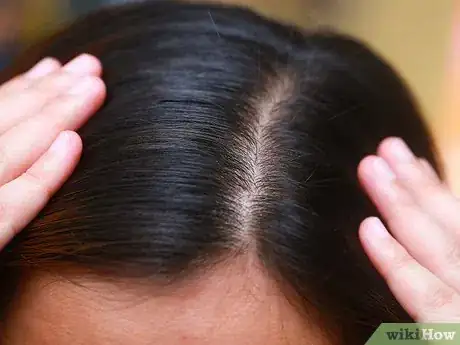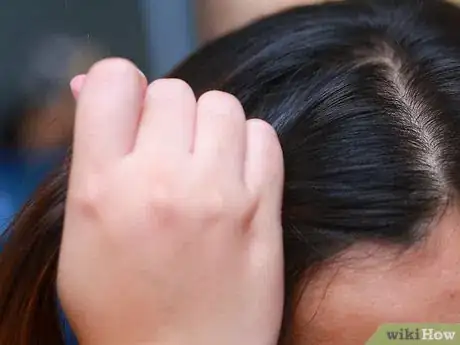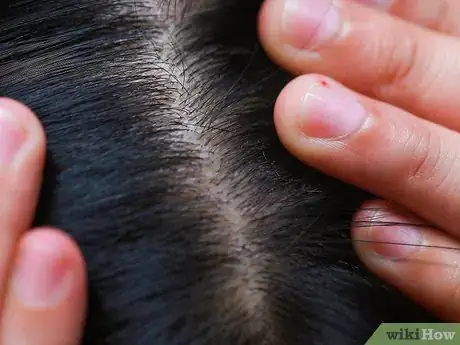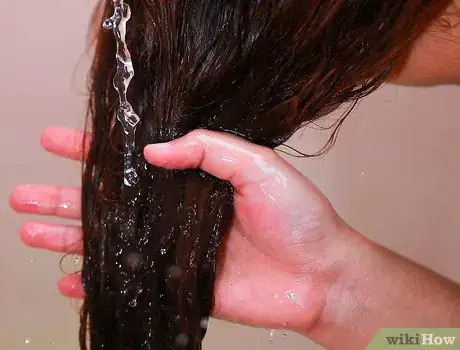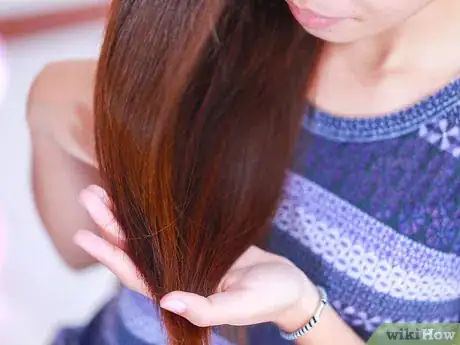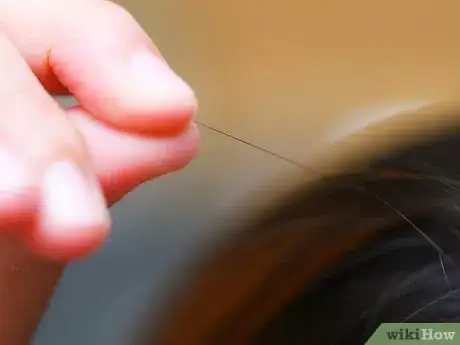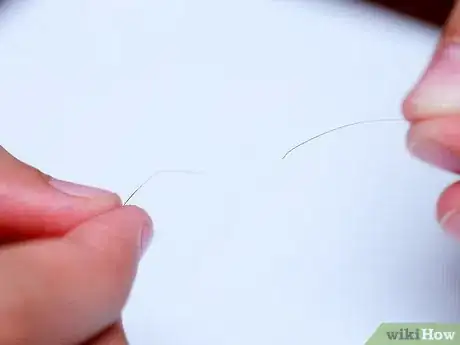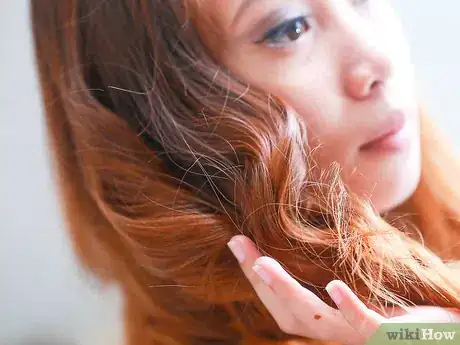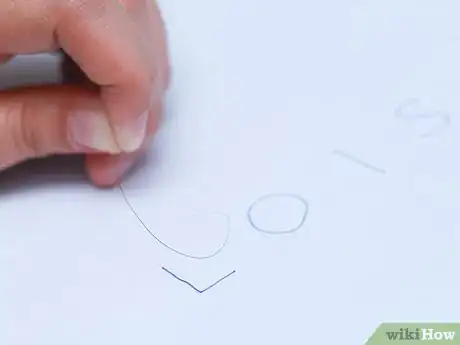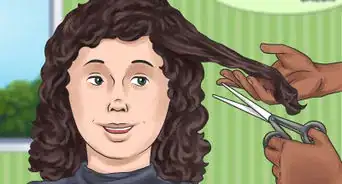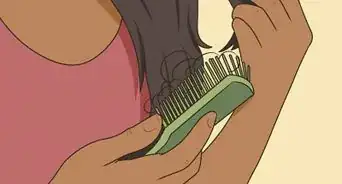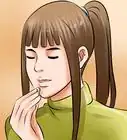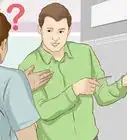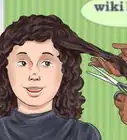This article was co-authored by Bianca Cox. Bianca Cox is a Hair Stylist, Licensed Cosmetologist, Owner of The Hair Throne, and Co-Owner of Bianchi Salon. Her salons pride themselves on their modernity, individuality, art, and professional services. You can check out The Hair Throne and more of Bianca's hairstyling on Instagram @hairthrone and on her personal Instagram @biancajcox.
This article has been viewed 667,828 times.
Determining your hair type will help you figure out how to handle, cut and style your hair more effectively. Hair type involves understanding different qualities of your hair, including density, texture, porosity (your hair’s ability to hold moisture), elasticity, and curl pattern. A hair stylist can use your hair type results to recommend the best hair styles, colors, and styling products for your hair.
Steps
Hair Type Guide
Density
-
1Look in a mirror and part your hair in the middle. Use your fingers or a comb to part your hair. Separate it into two sides. It might help to pin down one of the sides to keep it out of your way.
-
2Hold a chunk of hair on one side of the part. Move this chunk around a little bit so you can see the roots of your hair from a few different angles.
- Turn on a good light in your bathroom so you can get a good look at your hair. Alternately, have someone hold a lamp or flashlight above your head to give you more light.
Advertisement -
3Estimate your hair density. Your hair density is basically how many strands cover your head. Look at your hair roots and your scalp. How much of your scalp can you see in an area the size of a square inch?
- You’re not counting individual strands, but you can get a sense of how dense your hair is by how much skin you can see.
- Thick density: If you don’t see much scalp at all, you have thick hair density.
- Medium density: If you see some scalp, you have medium density.
- Thin density: If you see a lot of scalp, you have thin hair density.
-
4Test another spot on your scalp. Go through this same process at another spot on your scalp. Your hair density may be different at other spots on your head.
- Get a friend to help you look at the back of your head. Ask them to take a picture so you can see it more clearly.
Texture and Diameter
-
1Wash your hair. Using your regular shampoo and conditioner regimen, wash your hair as you normally would. Rinse your hair clean of shampoo and conditioner.
- Choose a time when you will not be exercising or creating a lot of extra sweat in your hair, which can alter your results.
-
2Let your hair air dry. Using a hair dryer might change the way your hair reacts in a certain amount of time, so using a towel and air to dry your hair is the best method.
-
3Cut a length of sewing thread about 6-8 inches long. Choose regular thread instead of a thicker thread intended for sewing heavy-duty fabrics.
-
4Pull out a strand of dry hair. Try to get the full strand, rather than having it break in the middle. You want to see how thick your hair is, so choose a strand of hair that is most representative of your entire head of hair. The crown of your head is the best area to get the strand from.
- Your hair should be dry, and have no styling products in it. It is best to leave styling products out of your hair while you’re testing it to get the most authentic results.
-
5Place the thread and hair strand side-by-side on white paper. Use a sheet of white paper to help you clearly see the hair strand and the thread so that you can compare them more easily.[1]
-
6Compare the hair strand to the thread. Take a close look at your hair, such as by using a magnifying glass or magnifying mirror. If it is really curly, stretch it out a bit before you compare it to the thread. It might help to tape down the strand and thread ends so they stay put.
- Thin hair: If the hair strand’s thickness is thinner than the thread piece, you have thin hair.
- Medium hair: If your hair strand is about the same thickness as the thread, you have medium hair texture.
- Thick hair: If the hair strand is thicker than the piece of thread, you have thick hair.
Porosity
-
1Wash your hair. Using your regular shampoo and conditioner regimen, wash your hair as you normally would. Rinse your hair clean of shampoo and conditioner. Make sure all chemicals and products are rinsed thoroughly out of your hair.
-
2Use a towel to partially dry your hair. Comb through your hair first and then gently squeeze your hair using a clean t-shirt or microfiber towel. Do not dry it too much, or else you may not be able to determine the porosity, or how well your hair retains moisture, very well.
-
3Feel your hair in your hands. Take chunks of hair in your hands and feel them from the roots down to the ends. Gently squeeze your hair to feel the moisture.
- Low porosity: If your hair feels almost dry, your hair has not retained much moisture and you have low porosity.[2]
- Medium porosity: If your hair is pretty wet but not sticky, then your hair retains a medium amount of moisture and you have medium porosity.
- High porosity: If your hair feels sticky, as though the water will take a long time to leave your hair, then you have high porosity. Your hair retains a lot of moisture.
-
4Float your hair in a large bowl of water. Pull out a strand of hair and float it in a large bowl of water. The bowl needs to be large enough so that the hair strand will not touch the sides. Observe what happens with the strand of hair.[3]
- Low porosity: If the strand floats and does not sink at all, you have low porosity.
- Medium porosity: A strand that sinks after a while will indicate medium porosity.
- High porosity: If the strand sinks to the bottom of the bowl quickly, you have high porosity.
-
5Test your hair again on a different day. The weather may affect your hair; if it is very humid, for example, your hair may react slightly differently than on a drier day.
Oiliness
-
1Wash your hair. Using your regular shampoo and conditioner regimen, wash your hair as you normally would. Rinse your hair clean of shampoo and conditioner.
- Choose a time when you will not be exercising or creating a lot of extra sweat in your hair, which can alter your results.
-
2Let your hair air dry. Using a hair dryer might change the way your hair reacts in a certain amount of time, so using a towel and air to dry your hair is the best method.
- Do not add any products to your hair, as this can alter your results.
-
3Let your hair sit overnight. Give your head and hair time (about 8-12 hours) to produce oils, which you will then be able to check.
-
4Check for oiliness. In the morning, press a tissue to your scalp at the crown of your head. Do not rub the tissue around; just a gentle press against your scalp will suffice. Press it against your head behind your ears as well.[4]
- Oily hair: If there is oil residue on the tissue, then you have oily hair.
- Medium hair: If you see a trace of oil on the tissue, you have medium hair.
- Dry hair: If there is nothing at all on the tissue, then you have dry hair.
- Combination hair: If there was no oil from one spot, but a lot of oil from another spot on your scalp, then you have combination hair.
-
5Test your hair again on a different day. The weather may affect your hair; if it is very humid, for example, your hair may react slightly differently than on a drier day.
Elasticity
-
1Pull out a strand of dry hair. A strand of freshly washed, towel dried hair will give you the best results. Try to get the full strand, rather than having it break in the middle.
- Your hair should be dry, and it can have styling products in it. It is best, however, to leave styling products out of your hair while you’re testing it in order to get the most authentic results.
-
2Stretch the strand of hair. Hold the strand of hair with your hands on both ends and pull. Stretch it gently.
- Don’t stretch it quickly or else it will break too soon. The strand of hair will snap eventually, but you want to see how much it will stretch before it breaks.[5]
-
3Observe what happens to the strand of hair when you stretch it out. Watch how it begins to stretch like a rubber band and pay close attention to when it breaks. Highly elastic hair will stretch when it is wet by up to 50% its original length before it snaps.
- High elasticity: If you can stretch the strand a long way before it breaks, you have high elasticity and very strong hair.
- Medium elasticity: If you can stretch the strand somewhat before it snaps, you have medium elasticity.
- Low elasticity: If the strand breaks almost immediately when stretching it, you have low elasticity and your hair may not be very strong. The strand may also stretch like bubbly gum, and when it breaks it may curl up.
-
4Test a strand of hair from another spot on your head. Your hair may have different elasticity on a different part of your head. If you pulled a strand from the crown of your head first, for example, try pulling out a strand from behind your ear or at the base of your scalp.
Curl Pattern
-
1Wash your hair. Using your regular shampoo and conditioner regimen, wash your hair as you normally would. Rinse your hair clean of shampoo and conditioner.
-
2Let your hair air dry. Using a hair dryer might change the way your hair reacts in a certain amount of time, so using a towel and air to dry your hair is the best method.
-
3Determine your hair’s curl pattern. Andre Walker, hairstylist for Oprah Winfrey, created a system for determining hair type primarily based on curl size and pattern.[6] This includes a range of hair types from straight to coily.
- 1 (straight): Hair has no curve in it at all.
- 2 (wavy): Hair is wavy but does not curl much.
- 3 (curly): Hair is curly with an S shape and holds a definite curl pattern even when unstyled.
- 4 (coily): Hair is tightly coiled or kinky, often with a definite Z pattern. It can be stretched out and will return to its curled shape when released. Type 4 hair might shrink up to 75% of its actual length.
-
4Find your hair subcategory. Take a look at a representative chunk of your hair. Observe the thickness and pattern of the curl (if you have curls). [7] , [8] These are also based on the Andre Walker system that categorizes hair into four types and three subcategories per type.
- 1A: Hair is soft and cannot hold a curl.
- 1B: Hair does not curl but has more volume.
- 1C: Hair does not curl and is rather coarse.
- 2A: Hair is wavy, resembling the letter S, and is coarse.
- 2B: Hair is often frizzy with a definite wave.
- 2C: Hair is very frizzy with thick waves, and is the coarsest of this category.
- 3A: Curls are about the same diameter as sidewalk chalk, or pretty loose curls.
- 3B: Curls are about the same diameter as a sharpie, or medium-sized curls.
- 3C: Curls are about the same diameter as a pencil, or corkscrew curls.
- 4A: Curls are very tight, about the same diameter as a needle.
- 4B: Curls resemble a zigzag pattern, looking like the letter Z.
- 4C: There might not be a curl pattern to this hair type. It has a tight zigzag with an uneven pattern, so it is harder to define.
-
5Compare your hair to the LOIS system. The LOIS system is a curl typing system that considers strand texture and thickness as well. It compares a strand of your hair to the letters L (Bend), O (Curl), I (Straight) and S (Wave).[9] Take a single strand and hold it up with one hand. Compare your hair to the shapes of the letters L, O, I and S.
- L: Your strand looks like the letter L, with right angles, bends and folds. This is kinky, zigzag pattern hair.
- O: Your strand resembles the letter O or spirals into several Os.
- I: Your strand is straight with little to no curves or waves, resembling the letter I.
- S: Your strand is wavy and curves back and forth like the letter S.
- Combination: Your strand might have a combination of two or more of these letters. If this is the case, check a few more strands of hair from all over your head to see if one of the letters is more dominant.
EXPERT TIPBianca Cox is a Hair Stylist, Licensed Cosmetologist, Owner of The Hair Throne, and Co-Owner of Bianchi Salon. Her salons pride themselves on their modernity, individuality, art, and professional services. You can check out The Hair Throne and more of Bianca's hairstyling on Instagram @hairthrone and on her personal Instagram @biancajcox.Professional Hair Stylist
 Bianca Cox
Bianca Cox
Professional Hair StylistIf you're still not sure what type of hair you have, talk to your stylist. It can be really hard for someone to determine their hair type themselves, so it can be helpful to make an appointment with a stylist. Then, they can assess your hair, and they can also advise you on the types of products to use, how to style your hair, and what kind of haircut will suit your hair type.
Expert Q&A
Did you know you can get expert answers for this article?
Unlock expert answers by supporting wikiHow
-
QuestionWhat is kinky hair?
 Laura MartinLaura Martin is a Licensed Cosmetologist in Georgia. She has been a hair stylist since 2007 and a cosmetology teacher since 2013.
Laura MartinLaura Martin is a Licensed Cosmetologist in Georgia. She has been a hair stylist since 2007 and a cosmetology teacher since 2013.
Licensed Cosmetologist
-
QuestionWhat are the different hair types?
 Laura MartinLaura Martin is a Licensed Cosmetologist in Georgia. She has been a hair stylist since 2007 and a cosmetology teacher since 2013.
Laura MartinLaura Martin is a Licensed Cosmetologist in Georgia. She has been a hair stylist since 2007 and a cosmetology teacher since 2013.
Licensed Cosmetologist
-
QuestionDo I have thick or thin hair?
 Laura MartinLaura Martin is a Licensed Cosmetologist in Georgia. She has been a hair stylist since 2007 and a cosmetology teacher since 2013.
Laura MartinLaura Martin is a Licensed Cosmetologist in Georgia. She has been a hair stylist since 2007 and a cosmetology teacher since 2013.
Licensed Cosmetologist
References
- ↑ http://www.curlynikki.com/2012/08/decoding-hair-texture-hair-typing.html
- ↑ http://www.xovain.com/hair/hair-type-analysis
- ↑ http://www.naturalhairrules.com/hair-typing-for-beginnings
- ↑ http://www.onlymyhealth.com/how-determine-your-hair-type-1298015585
- ↑ http://www.xovain.com/hair/hair-type-analysis
- ↑ http://www.naturallycurly.com/hair-types
- ↑ http://www.naturalhairrules.com/hair-typing-for-beginnings/
- ↑ http://www.curlynikki.com/2012/08/decoding-hair-texture-hair-typing.html
- ↑ http://www.curlynikki.com/2012/08/decoding-hair-texture-hair-typing.html
About This Article
To determine hair type, start by looking at your roots and scalp to determine hair density. Compare a strand of your hair to a piece of string to determine texture, then use touch to determine your hair's porosity while it's damp. Determine oiliness by checking how oily your roots are the morning after washing your hair. Stretch a strand of dry hair to determine elasticity, then observe your curl pattern to determine how curly your hair is. To learn about specific tests you can use to determine your hair type, read on!

